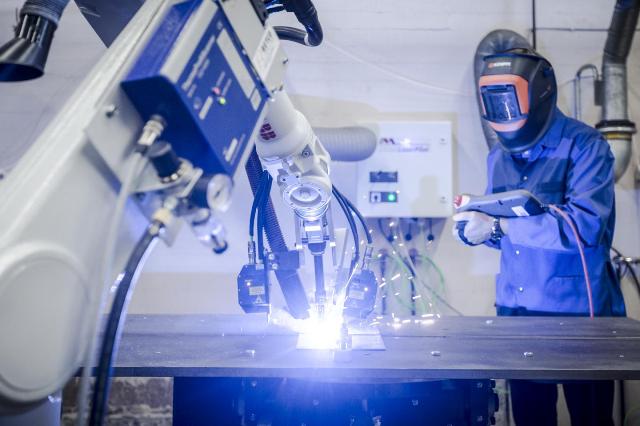Mar 23 2015
Lappeenranta University of Technology (LUT) is developing an entirely new kind of welding system, one which solves quality and productivity problems related to automated and mechanised welding. The system is self-adjusting, flexible and adaptable, such that it can be integrated as part of different robotic systems and different manufacturers' power supplies.
 This neural-network guided self-adjusting welding system was developed in Lappeenranta University of Technology (LUT), Finland. Credit: Teemu Leinonen, LUT.
This neural-network guided self-adjusting welding system was developed in Lappeenranta University of Technology (LUT), Finland. Credit: Teemu Leinonen, LUT.
It's self-adjusting properties are based on a new kind of sensor system which is controlled by a neural network program. Most often in welding a monitoring sensor is used which tracks the bevel angle, an essential part of the welding process. In the system being developed by LUT, there are also monitoring sensors for the thermal profile (the weld pool's heat values) and the weld form. The monitoring data is transferred from the sensors to the neural network, which is able to deduce and react to simultaneous changes in multiple variables.
'When a mistake is detected, the system is able both to correct it during the welding process and also calculate what other faults may arise. Thus the final product is flawless. The problem with welding automation systems is that certain values are set for the work, based on which the whole weld is carried out, and only then is it checked whether the result is good. Now the welding is monitored throughout the whole process', explains Project Manager Markku Pirinen.
In the gas-shielded arc welding process, factors affecting outcome quality include the welding current, the arc voltage, the wire feeding and transporting speeds, and the position of the welding gun. With the help of the neural network, a regulating window can be set for these system variables, and they can then be controlled so that they remain within certain limits, which ensures that final product is as required.
'In practice this means that when the welding values approach the boundary values set in the parameter window, the system corrects the process so that the welding values move back towards the centre of the value range and the possible defect is prevented.'
Added value for Arctic steel construction
The new system works very well with high-strength steel welding, as the parameter windows for the high-strength materials are significantly narrower than those for construction steel, and the harder the steel is, the more difficult it is to weld. High-strength steel is used, for example, in arctic steel construction work, where the materials used must be light, robust, and strong.
'In the Arctic, welds must be of higher quality than in warmer regions. In the North, errors would have catastrophic consequences. For example, the welds must be able to withstand temperature of up to -60 °C, and they must be flawless. Operating safety must be so high that no accidents occur at all', says Pirinen.
The market for the new system developed by LUT is worldwide. The system can be used, for example, in the manufacture and quality verification of pressure vessels, different kinds of containers, pipes and pipe systems, booms and beam structures. In Pirinen's opinion, the welding industry has been waiting for a control system such as this ever since automated welding came onto the market.
'This system will bring significant savings to the welding industry, as resources will no longer be required for post-welding checks and repairs. However, the system can only by used for mass-welding operations, so hand-operated welding will continue to be used for the kinds of work which the robotic welders cannot do.'
The budget for the Neural-network guided self-adjusting welding system project is approx. 800,000 euros, 70% of which will be provided by Tekes. The project is part of the Tekes TUTLI (New knowledge and business from research ideas) programme, aimed at the commercialisation of research results as new business activities. The project realizer is LUT's welding technology laboratory.